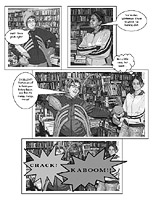- Categories:
Tapping Into the Growing Market for Graphic Novels
If any bookseller participating in ABA's Day of Education at BookExpo America had doubts about the market for graphic novels, they were put to rest at the panel "Buying, Merchandising, and Selling Graphic Novels, 101," featuring Jessica Stockton Bagnulo, graphic novels buyer and author events coordinator at McNally Robinson Booksellers in New York City; comic artist Scott McCloud; and John Shableski of Diamond Book Distributors.
 John Shableski, Scott McCloud, Jessica Stockton Bagnulo, and Lisa Winn. |
ABA education coordinator and panel moderator Lisa Winn began the session pointing to the incredible popularity of graphic novels, which, according to ICv2, grew in number by 22 percent, from 2,785 published in 2006 to more than 3,390 in 2007.
Stockton Bagnulo noted that graphic novels have a higher turn than any other category at McNally Robinson. And Shableski put the category's significant growth in perspective: "In 2001, $43 million in graphic novels were sold. Last year, graphic novels did $375 million in sales."
And, Shableski said, "Kids get hysterical about them... that's an audience you need to tap."
"There's a reason [young people are] buying graphic novels," added McCloud, pointing to the popularity of manga -- a Japanese graphic novel form that generally reads right to left --among children ages 12 - 15. "It promotes a sense of participation. They're really fascinated by it -- they want to know what will happen with their favorite characters."
Said Shableski: "Kids like manga because [adults] don't like it, but there are great stories in there. And the loyalty that readers have for the characters is amazing."
For the uninitiated, stocking a graphic novel section can be daunting, in part, because of the category's diversity.
"There is an incredible diversity and sophistication in graphic novels," Stockton Bagnulo said. And because of the variety of graphic novels, booksellers would be best served by shelving them by category, such as manga, superhero (traditional comic books), and a general graphic novel section. "It makes a lot of sense to separate them -- they're also sized differently. Shelving them separately but adjacent to each other is the way to go," she added.
As for deciding what to stock, McCloud recommended that booksellers find someone on their staff who is familiar with graphic novels, such as manga, which can be difficult to get a bead on, and have them buy for the store.
Importantly, booksellers should never dismiss the self-published graphic novelist. "Self-published comics are where you can find some of the best indie comics," Stockton Bagnulo reported.
Although most buyers of graphic novels are on the young side, the perception of the category is slowly changing and older adults are starting to take it seriously. Still, booksellers will find adults who scoff at the notion of buying their child, other young relative -- or even themselves -- a graphic novel because they don't perceive it as a serious form of art or literature.
But, Stockton Bagnulo tells doubters, "If it's being reviewed in the New York Times Book Review, then I think it's a book."
"I'll just hand them a copy of Mom's Cancer (by Brian Fies, Abrams)," said Shableski, adding that the graphic novel version of the 9/11 Commission Report is another great example of a serious read.
For those booksellers who are worried that graphic novel buyers will simply shop at the local comic book store and leave their new graphic novel section to collect dust, Shableski assured attendees: "They are two different audiences, comic book people and the type of people coming to your store who you are introducing to this."
A unique three-part Graphic Novels session handout, created by Winn, and a list of graphic novel classics as well as comics for kids, complied by Stockton Bagnulo, are available to ABA member booksellers via BookWeb.org. --David Grogan
|
Links suggested by John Shableski: www.icv2.com: tracks sales of anime and manga, graphic novels and comics, games, toys, and movies. Links suggested by Jessica Stockton Bagnulo: www.shelf-awareness.com |


